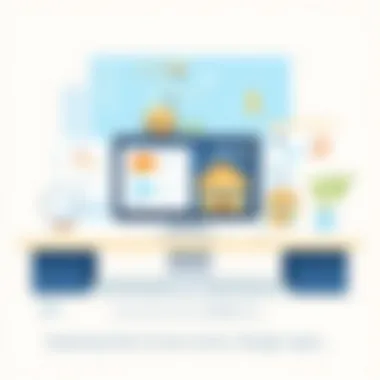Top Free Construction Design Apps Reviewed for Efficiency


Intro
In the fast-evolving landscape of construction and architecture, technology has become indispensable. Free construction design apps stand at the forefront of this shift, making tools that once required hefty budgets accessible to a broader audience. As we navigate through various applications, we will uncover how these tools foster enhanced creativity and sharpen efficiency in construction planning. The digital age has ushered in a new opportunity for design professionals, from seasoned architects to emerging entrepreneurs, promoting innovation without breaking the bank.
Understanding the significance of incorporating these applications can be game-changing, enabling professionals to visualize concepts, manage projects seamlessly, and communicate with team members effectively. Whether you’re a seasoned pro seeking to explore fresh options or a newcomer trying to find your footing, this exploration promises insights that resonate across the construction industry.
Key Features
Overview of Features
When evaluating free construction design apps, several core features emerge as essential:
- User-Friendly Interface: A clean, intuitive layout is vital. End-users benefit from apps with easy navigation, allowing them to focus on design rather than wrestling with complicated tools.
- Collaboration Tools: The ability to share designs and collaborate in real-time is crucial in today’s remote-working landscape. Many apps provide cloud-based solutions or integrations that facilitate teamwork.
- 3D Rendering: The ability to turn 2D blueprints into 3D models can bring designs to life. Features like virtual tours offer a better understanding of space than traditional drawings ever could.
- Customization Options: Tailoring designs to suit specific needs is essential. Apps that provide varied templates or customization capabilities allow users to align with their unique visions.
- Exporting and Sharing Features: Users should easily export designs in various formats suitable for presentations, further client discussions, or collaboration.
Unique Selling Propositions
Every construction design app has its unique charm, catering to different niches within the industry:
- Tinkercad: Focused on those diving into 3D modeling, Tinkercad simplifies the design process, making it ideal for beginners or educators in STEM fields.
- SketchUp Free: Known for its robust 3D modeling capabilities, it offers a smooth balance between ease of use and powerful tools, suitable for both amateur and professional designers.
- Planner 5D: This app leverages intuitive drag-and-drop features, empowering users to create detailed home layouts and interior plans with minimal fuss.
- Muro: Muro's emphasis on collaboration and sharing stands out, catering particularly to teams working on large-scale projects where input from various stakeholders is necessary.
Understanding these unique offerings helps decision-makers align their operational needs with the right tool.
Pricing Models
Different Pricing Tiers
While the focus here is on free offerings, it’s important to note that many apps have premium tiers. These might include:
- Monthly Subscriptions: Users can enhance their experience through a modest monthly payment, unlocking advanced features and tools.
- One-Time Payments: Some platforms allow users to purchase specific tools or capabilities outright, which can be beneficial for those who only need certain functionalities.
ROI and Cost-Benefit Analysis
Investing time into exploring free applications can lead to significant returns. By potentially cutting down on project turnaround times and reducing the need for extensive training, firms can see elevated productivity levels.
"In an industry where every minute counts, leveraging technology effectively could mean the difference between project success and failure."
Professionals evaluating free construction design apps must consider the long-term advantages against the immediate lack of cost. An app that facilitates better communication and workflows can ultimately yield a greater financial benefit, outweighing upfront investments in premium features or services.
In summary, free construction design apps are reshaping the landscape of architectural and construction planning, providing vital tools that enhance design processes while being budget-friendly. Picking the right tool can streamline operations and ignite creativity, essential for thriving in a competitive environment.
Intro to Construction Design Applications
In the rapidly evolving world of construction, design applications have transformed how architects, engineers, and builders approach their projects. They provide powerful tools that streamline the design process, enhance communication, and improve project outcomes. Implementing construction design applications is not merely beneficial; it has become essential for success in an increasingly competitive field.
Given the complexity of modern construction projects, these applications allow for a visual representation of concepts, making it easier to foresee potential issues and make informed decisions. Meanwhile, they facilitate collaboration among diverse teams, enabling stakeholders to share ideas and feedback seamlessly.
Understanding the Role of Technology in Construction
As technology find its footing in the construction domain, the integration of digital tools has become a game changer. New tech innovations are reshaping how design and planning processes occur. Starting from Building Information Modeling (BIM) to cloud collaboration tools, construction technology has become a significant driving force behind productivity and safety.
With these technologies, the entire management process receives a boost. Information can be stored, accessed, and modified in real-time, eliminating miscommunication and enhancing overall efficiency. According to a report by the McKinsey Global Institute, construction productivity could rise by 15% with creative use of technology.
When stakeholders can visualize and manipulate designs in real-time, it significantly reduces the chances of errors and costly revisions down the line. Moreover, technology serves as a bridge, connecting various project participants—designers, contractors, clients—allowing for smoother workflows and fostering a collaborative spirit.
The Rise of Free Applications in Construction Design
In recent years, free construction design applications have garnered substantial attention. As the market diversifies, countless platforms have emerged, making powerful design tools accessible to a wider array of users, including startups and small businesses that might not have the budgets for paid software.
These applications typically provide a basic set of features that enable users to create 2D and 3D models, visualize spaces, and experiment with different design elements without incurring significant costs. Platforms like SketchUp Free and Floorplanner appeal to a broad range of users because they allow even the most novice designers to dip their toes in the construction design waters.


Moreover, the rise of online learning resources facilitates skill development, enabling users to maximize the potential of these free tools. By tapping into community forums or tutorial videos on platforms like YouTube, users can embrace the design applications without fear of feeling lost, making the journey a bit more navigable.
Being able to use these apps at no cost means that affordability remains a prominent aspect of modern construction projects. Challenging the status quo, it creates space for innovation in design and pushes users to explore beyond traditional boundaries, thereby enriching the entire landscape of construction design.
Key Features of Effective Construction Design Apps
In the fast-paced world of construction, having the right tools can spell the difference between a successful project and a botched one. Free construction design apps offer a plethora of features, each playing a pivotal role in the development and planning stages. The effectiveness of these applications hinges on several key aspects that not only enhance productivity but also foster creativity.
User Interface and User Experience Considerations
A crucial element of any design app is its interface. A smooth, intuitive user interface is like a breath of fresh air for users—no one wants to wade through a complex maze just to get their job done. When considering design applications, look for those that prioritize user experience. Clear navigation, aesthetically pleasing layouts, and helpful tooltips can all make life easier. A well-designed app reduces the learning curve, allowing teams to jump in without extensive training.
Moreover, a positive user experience can lead to higher adoption rates within organizations. If an app is frustrating to use, even the most advanced features become moot. When evaluating an application, consider asking questions like:
- Does it support drag-and-drop functionality?
- How easily can users customize their workspace?
- Is there a mobile version for on-the-go access?
Collaboration Tools for Project Teams
Collaboration is at the heart of any construction project. Construction teams come from diverse backgrounds; architects, engineers, contractors, and clients all have a say. Effective construction design apps support collaboration features that allow these groups to communicate seamlessly. Tools such as chat functions, real-time updates, and shared project timelines encourage teamwork and transparency.
Many applications also offer cloud storage capabilities. This means that everyone involved in the project can access the latest revisions, mitigating the risk of outdated information causing confusion. To enhance collaborative efforts, the following features should be on anyone's radar:
- Shared access to designs and revisions.
- Commenting systems that allow feedback directly on the design.
- Version tracking to monitor changes over time.
Integration Capabilities with Other Software
The effectiveness of construction design apps is further amplified when they can integrate with other essential software solutions. Imagine trying to run a tight ship without being able to connect your design app with project management tools or accounting systems. Such integrations streamline processes and improve data accuracy across platforms. The ability to import and export files from different software enhances operational fluency.
Key integrations to consider include:
- Tools like Microsoft Project or Trello for task management.
- Financial software for budgeting and invoicing, such as QuickBooks.
- BIM software for detailed model analyses and sharing.
By selecting apps that offer robust integration capabilities, teams can foresee hurdles and minimize manual data entry, thereby reducing the likelihood of errors and ensuring smoother project flow.
"The right technology can empower your team, enhancing not just their capabilities but also their innovative potential."
In summary, understanding and focusing on these key features—user interface and user experience, collaboration tools, and integration capabilities—will help you select the most effective free construction design apps for your projects. In the evolving landscape of technology, staying ahead is all about choosing the right tools that facilitate both individual contributions and collective teamwork.
Benefits of Using Free Construction Design Apps
In the rapidly evolving realm of construction and design, free software solutions have emerged as vital tools that can transform workflows and enhance project outcomes. By offering cost-effective alternatives to expensive software, these applications provide significant benefits that can greatly influence the decision-making processes of industry professionals. Understanding these advantages helps businesses leverage technology effectively, ensuring they stay competitive and innovative.
Cost Efficiency and Budget Management
One major advantage of utilizing free construction design apps is the cost efficiency they bring. This effectively reduces financial strain, especially for startups or small firms that might not have hefty budgets. Without the burden of software licensing fees or hefty subscription costs, firms can allocate financial resources to other pressing areas, such as on-site labor, materials, or technology upgrades.
This focus on budget can lead to higher profitability without compromising project quality. For example, software such as SketchUp Free provides robust design tools, allowing construction professionals to create high-quality models without dipping into their wallet. In the long run, adopting these free tools can also foster better budget management, giving firms the opportunity to experiment with different design concepts without the fear of incurring costs.
Accessibility for Small Businesses and Startups
Accessibility is another cornerstone benefit of free construction design apps. These tools level the playing field for small businesses and emerging startups. Companies that may lack the capital to invest in high-end software options can nonetheless access advanced design functionalities. This democratization of technology enables smaller contractors and architects to participate fully in competitive bid scenarios.
Moreover, many of these applications can be used on various devices, from smartphones to tablets, allowing teams to work remotely or on-site. For instance, platforms like AutoCAD Mobile App allow users to access their designs on the go, ensuring that they can make adjustments in real time, wherever they are. This flexibility enhances operational efficiency, as teams can stay connected and reactive to changing project demands.
Encouraging Innovation and Creativity
Free construction design apps not only remove financial barriers but also serve as platforms for innovation. The lower entry threshold encourages a culture of creativity and experimentation, allowing designers and architects to try out new ideas without the risk of costly failures. Many professionals in the field find themselves utilizing free tools not just to execute projects, but also to prototype new concepts that might have otherwise remained unexplored.
Additionally, because freemium models often introduce users to the broader suite of tools available, they provide a pathway for learning and development. For example, a user might start with a free version of Planner 5D and later decide to upgrade as they grow more confident or need additional features. By having this incremental approach, professionals can pace their learning processes and innovation, ultimately resulting in a more robust design process.
"The tools we choose shape the outcomes we achieve. Free construction design apps enable cost-effective, accessible, and creative approaches to design in a fast-paced industry."


Comparative Analysis of Popular Free Construction Design Apps
In the construction industry, technology continuously shapes how projects are planned and executed. A comparative analysis of popular free construction design apps offers insights into each app's strengths and weaknesses, helping professionals make informed decisions. Factors like functionality, ease of use, and collaborative capabilities play key roles in determining which software fits best for specific project needs. This section serves as a guide to uncover the nuances of these tools, often leading to significant time and cost savings for businesses.
AutoCAD Mobile App: Features and Limitations
The AutoCAD Mobile App brings new dimensions to construction design right at your fingertips. It allows users to view, create, and edit drawings on mobile devices. Some notable features include the ability to work in both 2D and 3D, a portable interface that integrates well with existing AutoCAD software, and the functionality to share drawings with team members effortlessly.
However, despite its vast potential, there are limitations worth noting. For instance, while the mobile app is user-friendly, it might lack some advanced features found in the desktop version. Users often report that more complex designs can be cumbersome to execute on mobile, particularly when precision is crucial.
"With AutoCAD Mobile, you can literally design on the go, but ensure your plans are well thought out before making changes on a smaller screen."
SketchUp Free: Usability in Design Projects
SketchUp Free stands out for its intuitive user interface, encouraging both novices and experienced designers to explore a wide range of design possibilities. One of the most appealing aspects of SketchUp Free is its web-based nature, eliminating the need for hefty downloads or installations. Users can access the platform from virtually anywhere, making it perfect for collaborative projects.
Moreover, it supports a wealth of community-generated content, offering users access to a plethora of templates and 3D models. Yet, some users mention that while the free version is robust, it does have functional limitations, particularly regarding the export options and offline capabilities. For extensive projects requiring nuanced details, these restrictions may necessitate consideration of premium upgrades or alternative software.
Floorplanner: Simplifying Visual Layouts
Floorplanner presents a straightforward way to create floor plans and visual layouts. It's particularly user-friendly for those new to architectural design, providing a drag-and-drop interface that simplifies the process of arranging rooms and furniture in a 2D view. Users can transition seamlessly to a 3D view, giving a better perspective of the layout.
However, While Floorplanner excels in layout simplicity, it may not cater well to advanced design features like electrical layouts or intricate structural details. The platform mainly focuses on floor planning, which can limit its appeal for comprehensive construction projects. Yet, for quick visualizations or simple residential projects, it serves as an excellent tool.
Planner 5D: Comprehensive Design Tools
Planner 5D is another versatile app widely favored by users for creating detailed interior designs. It offers an extensive library of furniture, materials, and textures, allowing users to craft aesthetically pleasing spaces. The inclusion of AI for automatic layouts enhances the user experience, especially for beginners who may not have a keen eye for design.
However, some professionals highlight that its robust features can sometimes come with a steep learning curve. Also, while the free version is quite capable, advanced functionality—such as exporting designs or accessing certain premium features—might open the wallet a bit more. Overall, Planner 5D balances complexity and simplicity well, making it suitable for a diverse range of projects.
By taking the time to compare these applications, construction professionals can make better choices that align with their specific needs, balancing features against usability and cost. As each app carries its unique set of advantages and constraints, understanding these nuances helps to enhance workflow efficiency and project outcomes.
User Reviews and Experiences with Free Apps
In the digital age, user feedback carries a weight that can heavily influence potential users' decisions. When it comes to free construction design apps, user reviews and experiences serve not only as a guide but also as a reality check. They can reveal what the marketing glosses over, highlighting real-world functionality, user challenges, and the overall satisfaction amongst users. Understanding these insights can help make more informed decisions, allowing budding architects and project managers to choose tools that suit their specific needs.
Moreover, user reviews often contain invaluable tips and tricks that can enhance the usability of the apps. These firsthand accounts provide context that is missing in official descriptions or marketing materials. By engaging with these experiences, potential users can sidestep common pitfalls and take advantage of features they might otherwise overlook.
Real-world Examples of Use Cases
The beauty of free construction design apps is their versatility across various scenarios. Consider a small startup specializing in eco-friendly homes. This team might utilize the SketchUp Free app for designing their unique structures, allowing them to create 3D models effortlessly. A notable case involved a small firm successfully creating a community garden layout, streamlining the design phase and garnering positive engagement from the local community.
Another example comes from the flooring sector. A contractor using Floorplanner showcased their ability to quickly mock up floor layouts for clients, ensuring clear visual expectations. This not only reduced back-and-forth discussions but also increased client satisfaction with the design presentations, demonstrating the potential of these tools in enhancing communication and clarity.
Insights from Construction Professionals
Insights from seasoned construction professionals can add substantial weight to our understanding of free design apps. Many professionals advocate for these tools, especially for their introductory utility. An architect noted that while advanced features may be lacking in free versions, they are particularly effective for preliminary design drafts, making adjustments easier before advancing to more complex software solutions.
Additionally, professionals recommend paying attention to user interfaces. A civil engineer on a forum expressed how an intuitive design can save time, allowing users to focus on creativity rather than getting bogged down by technicalities. For larger projects, collaboration features are often hailed as a game-changer, allowing teams dispersed over geographical distances to work together in real-time, crucial in today’s remote working environment.
"With the right construction app, even a small crew can efficiently transform ideas into visual designs without the need for hefty software investments." - Construction Professional
Best Practices for Implementing Construction Design Apps
Implementing construction design apps effectively is crucial for optimizing the overall workflow of any project. These applications can significantly enhance coordination among team members, provide real-time updates, and streamline operations. However, simply downloading and installing these tools is not enough. It's essential to approach implementation thoughtfully to ensure that their integration into daily activities yields the desired outcomes.
Training Your Team on New Software
When it comes to new software, the old saying "a chain is only as strong as its weakest link" rings true. This is especially relevant in the context of construction design applications. Training your team on how to use new software is not merely a best practice; it's an imperative step towards productive usage.
- Establish Clear Objectives: Understand what you want your team to achieve with the new tool. Discuss goals in a collective meeting that includes all stakeholders. This frames the use of the software in a beneficial light.
- Structured Training Sessions: Conduct structured training sessions that cover all the corners of the software. It's advisable to start with the basics—how to navigate the app—and gradually move onto more complex functionalities.
- Encourage Continuous Learning: Establish a culture of continuous learning. Utilize resources like online tutorials or forums from platforms such as Reddit, where users often share insights and solutions to common problems.
- Provide Reference Materials: Create a handbook or resource document that summarizes key features of the software. This serves as a quick reference guide for team members who may need to brush up on specifics.


Establishing a Workflow That Maximizes Efficiency
A well-thought-out workflow can be the backbone of any successful construction project. Establishing a structured workflow using construction design apps not only reduces the likelihood of errors but also improves accountability within the team.
- Define Roles and Responsibilities: Using a construction design app shouldn't muddy the waters when it comes to roles. Clearly outlining the responsibilities of each team member can ensure that everyone knows what is expected of them and avoid any overlap in tasks.
- Utilize Collaboration Tools: Many construction design apps come equipped with features designed for collaboration. Make full use of these tools to allow for seamless communication, document sharing, and version control.
- Regular Feedback Loops: Reinforce an agile approach by implementing regular feedback loops. This could be through weekly update meetings where the team reviews what’s working, what’s not, and how the workflow could be improved.
- Monitor and Adjust: Collect data on how the workflow is functioning. Keep an eye on deadlines, task completion rates, and any roadblocks. Adjust the workflow as necessary to enhance productivity.
"A solid implementation of technology not only boosts efficiency but can also inspire your team to reach new heights of creativity in their projects."
Employing these best practices can turn a potential pitfall into a launchpad for success.
Challenges and Limitations of Free Construction Design Apps
The construction industry has seen a surge in the use of free design applications, yet their potential benefits often come coupled with certain challenges and limitations. Understanding these challenges is crucial for professionals who rely on these tools to facilitate their projects. While free apps provide an entry point for smaller firms or independent professionals, they might not always deliver the reliability or comprehensive features found in premium options. Below, we delve deeper into the hurdles that users may encounter while navigating free construction design applications.
Technical Barriers and Software Bugs
When it comes to using free construction design apps, it's not uncommon for users to face various technical barriers. Often, these applications may come with software bugs that hinder the design process. Bugs can manifest in many forms, from unexpected crashes to issues that disrupt workflow and productivity. For instance, a designer working on a layout might find that their program shuts down unexpectedly, resulting in lost progress and frustration.
Additionally, if the app relies on cloud storage, slow internet connections can exacerbate the issue, causing delays in loading times. Users may also encounter compatibility issues with different operating systems or devices, leading to a disjointed experience. In some cases, technical support may be lacking or non-existent for free apps, leaving users on their own to resolve these issues. Navigating these tech-related hurdles can be time-consuming and may reduce the overall effectiveness of the tools.
Limited Features Compared to Paid Alternatives
Another significant obstacle arises from the limited features present in free construction design apps compared to their paid counterparts. While some applications offer the basics, they often lack the more advanced functionalities that seasoned professionals might expect. For instance, features like advanced rendering, collaborative tools targeted specifically at larger teams, or extensive libraries of materials and textures are often missing.
As an example, an architectural firm looking to create high-quality presentations may find that a free app lacks the nuanced graphics or professional templates necessary to impress clients. Similarly, batch processing options for mass editing designs might be absent as well, forcing users to do the work manually. As many industry players know, such limitations can stunt creativity and project development, potentially compromising the final output.
"While free apps serve as a great starting point, they frequently don’t meet the sophisticated needs of professional design, pushing users towards premium solutions."
Thus, it becomes vital for businesses and individuals to weigh the pros and cons of adopting free construction design tools, ensuring that they align with long-term goals and project demands. The opportunity for skill enhancement and cost savings must be balanced with an understanding of potential limitations that could arise over time.
The Future of Construction Design Technology
Looking towards tomorrow in construction design, one can't help but marvel at how technology is reshaping the industry's landscape. The intersection of construction and design is rapidly evolving, forming a new horizon for professionals engaged in building spaces. With free construction design applications gaining momentum, understanding their potential impact is crucial for staying ahead in the game.
All along, the role of technology has been simple: enhance the efficiency, quality, and creativity in the architectural vision. As we plunge deeper into this age of digital transformation, several specific elements demand our attention. Here’s a closer look at what the future might just hold:
Emerging Trends in Design Applications
As we step into a new era, several trends are bubbling to the surface in the realm of free construction design apps.
- Cloud Integration: This tech advancement fosters real-time collaboration, allowing teams to work from anywhere, anytime. Those in the field and behind a desk can sync on project changes instantaneously. Consider it a lifesaver for those juggling multiple projects at once.
- AI-Assisted Design: The push towards artificial intelligence is changing the game. Apps are beginning to introduce features that can suggest design elements based on user inputs, or even generate entire design drafts in mere moments. This helps professionals avoid the creative rut and spurs new ideas.
- Mobile Accessibility: The ability to access powerful design tools right from a smartphone or tablet is becoming essential. Busy professionals can make swift changes and communicate with teammates while on job sites, tweaking plans at a moment's notice.
- Sustainability Integration: Eco-conscious designs are on the rise. Many apps now include features that help users select materials based on their environmental impact, aiding in the creation of eco-friendly structures. This caters to an increasing demand for responsible construction practices.
Predicted Advancements in Free Software Solutions
While reflecting on the present, one must look to the future advancements that will likely shape free construction design software:
- Advanced Customization Options: Future iterations of these applications are expected to empower users with even more customizable templates. Tailoring designs to specific needs can enhance functionality—think of it as adding personal flair to an otherwise standard structure.
- Enhanced User Experience: Simple, intuitive interfaces are the name of the game. As technology matures, developers will likely focus on reducing the learning curve, making it easier for newcomers to dive into design without exhaustion.
- Blockchain for Security: With rising concerns over data security, the integration of blockchain technology could be on the roadmap for free software. This offers secure transactions and safeguarding of intellectual properties.
- Real-time Augmented Reality (AR) Integration: Imagine integrating AR capabilities, allowing clients to visualize designs on-site before construction kicks off. Such innovations could vastly improve approval processes and satisfaction rates for clients.
"The future belongs to those who believe in the beauty of their dreams."
As we gear up for what's ahead, keeping ahead of these trends will ensure that professionals remain not only relevant but also significant players in the field. For more insights into technology's role in construction, visit en.wikipedia.org or explore emerging technologies in construction on britannica.com.
The End: Assessing the Impact of Free Design Apps
In today’s rapidly evolving construction landscape, the use of free design applications is becoming not just a trend, but a necessity. This article has highlighted the essential role these tools play in enhancing efficiency and fostering creativity. By examining various options, we’ve seen that free construction design apps are more than just budget-friendly alternatives—they are powerful resources that can level the playing field for smaller firms and innovative startups.
The importance of understanding how to leverage these apps cannot be overstated. They provide unique functionalities that allow professionals to visualize their projects effectively without the burden of hefty software costs. This access democratizes design capabilities, giving budding architects or small businesses a fighting chance in a competitive market.
Key Benefits of Free Design Apps
- Cost Efficiency: One of the most significant advantages is their zero cost, which eliminates financial barriers to entry. This is particularly valuable for small businesses that operate on tight budgets.
- User-Friendly Interfaces: Many free apps feature intuitive designs that help streamline the user experience, making it easier for teams to adopt these technologies without extensive training.
- Flexibility and Adaptability: As construction projects vary widely, having a suite of versatile tools available for free allows for quick adjustments and adaptation without worrying about escalating costs.
"The best tool is the one that empowers you to turn your vision into reality, regardless of your budget."
Final Thoughts for Industry Professionals
For industry professionals, it’s critical to stay updated—not only on which applications are available but also on their evolving capabilities. As technology advances, so too will the features and tools offered in free construction design apps. It is wise to continually explore new solutions that may better meet the needs of current and future projects.















